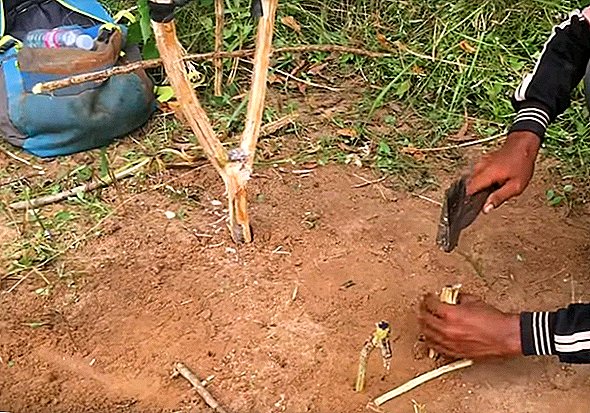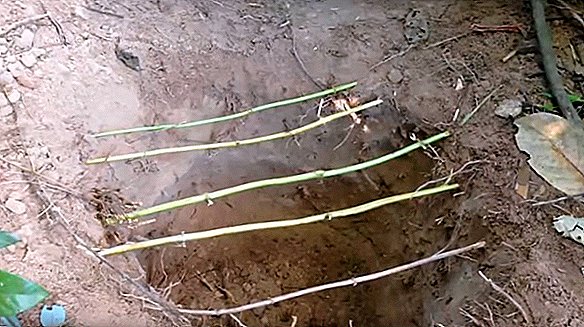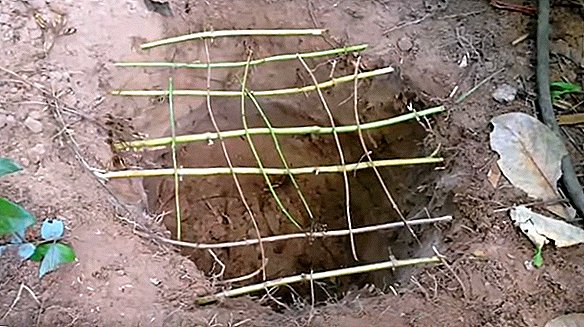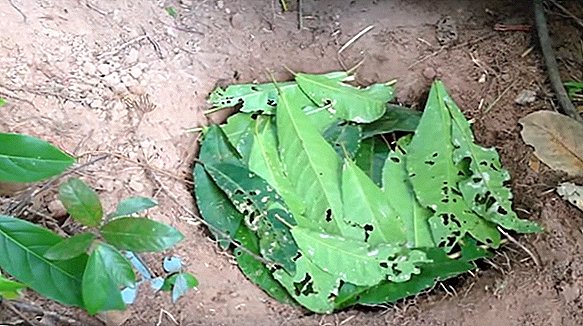 Rabbits are very nimble and frisky animals, even if they are not as fast as their close relatives hares. That is why catching an escaped animal is not an easy task, especially if it has fled to an open area: to a garden or a vegetable garden. How to return the fugitive, and what methods of capture can be taken - this will be discussed further.
Rabbits are very nimble and frisky animals, even if they are not as fast as their close relatives hares. That is why catching an escaped animal is not an easy task, especially if it has fled to an open area: to a garden or a vegetable garden. How to return the fugitive, and what methods of capture can be taken - this will be discussed further.
How to catch an escaped domestic rabbit
Often, even socialized pets, smelling the smell of freedom, can escape from the owner, refusing to return to the cage. However, many of them will run away from the owner, it is only that approach. In order for a fugitive to catch a fugitive to succeed, it is important to accurately recognize all of the eared behaviors that signal his intentions. These signals primarily include the following:
- banging hind legs on the floor - the rabbit is ready to leave the place and run at any time;
- stand on hind legs and pointy ears - the animal listens, he is interested in something;
- tight to the surface - The animal is very scared, especially if it heard unfamiliar loud sounds.
 The rabbit is standing on its hind legs and sharpening its ears - one of the escape signals from the host. Of all the listed behavioral features, the latter is most favorable for catching, because sometimes the fear is so strong that it literally paralyzes your pet, immobilizing him for a time sufficient for to grab it.
The rabbit is standing on its hind legs and sharpening its ears - one of the escape signals from the host. Of all the listed behavioral features, the latter is most favorable for catching, because sometimes the fear is so strong that it literally paralyzes your pet, immobilizing him for a time sufficient for to grab it.In order to properly organize the care and maintenance of eared animals, it is necessary to become familiar with all the subtleties of breeding rabbits at home, and also recommend finding out the advantages and disadvantages of keeping rabbits in the country.
It is good if the owner teaches the pet to respond to his call in advance. In this case, there will be no difficulties in capturing, just call your pet and offer him a tasty delicacy. For this, the animals willingly leave the playground and return to the cage.
Complicate the situation may inconspicuous escape of a pet, when the owner just did not have time to notice where he went. In this case, first you need to inspect all the nearby cracks and secluded places, especially in the area where he was last seen. As close as possible to the animal, it remains only to gently, without unnecessary movements, grab it by the skin and carry it to the cage.  If the search is not crowned with success, you can leave a self-closing cage in the room with a rabbit's favorite delicacy inside: it will surely get into it as soon as it gets hungry.
If the search is not crowned with success, you can leave a self-closing cage in the room with a rabbit's favorite delicacy inside: it will surely get into it as soon as it gets hungry.
How to catch a rabbit in the garden
If you catch a rabbit in a house is rather difficult, all the more difficult it is in a vegetable garden, where it has many ways of escape. This is especially true of animals kept in cages, which may well accidentally jump out. Sometimes it happens that you can lose sight of them for a while, so all actions should be performed in the following sequence:
- Assess the situation and determine the place of shelter of an eared fugitive (this may be bushes or dense thickets of a vegetable garden, for example, corn).
- In places where there are a large number of tracks, place traps, the trigger mechanism of which will be located as close as possible to the door (this will allow the cage to be slammed as soon as the animal gets inside).
- You can bring the rabbit to the established trap with the help of food, which should be laid out in the place where there are the most traces left (naturally, you need to pour treats and into the cage itself).
 You can check the trap 1-2 times a day, and during this time you usually manage to catch a home runaway. If we are talking about wild animals, it will take more time to catch this way; if during the week the trap remains empty, it means that it will have to be moved to another place. Caught wild animals are taken away to a place where they will not be able to harm crops and trees.
You can check the trap 1-2 times a day, and during this time you usually manage to catch a home runaway. If we are talking about wild animals, it will take more time to catch this way; if during the week the trap remains empty, it means that it will have to be moved to another place. Caught wild animals are taken away to a place where they will not be able to harm crops and trees.We recommend to learn how to determine the sex of a rabbit, why rabbits grow poorly and do not gain weight, and what affects the lifespan of rabbits.
Wild Rabbit Fishing Techniques
Unlike domestic and decorative, wild rabbits generally prefer not to approach a person, so it is extremely difficult to catch them. Best suited for this purpose:
- snare
- wolf pits
- self-closing cells.
 Rabbit trap
Rabbit trapUsing silk
In order to get maximum results from the use of silk, it is important to consider several factors:
- it is advisable to find in advance a place with a natural arch or a short manhole located on the rabbit trail (a little later the snare will be hooked for it);
- if such a restriction could not be found, you will have to create an artificial obstacle, the role of which is perfectly suitable for a large branch or a young tree that helps to form an arch (the main thing is to make sure that the chosen element is heavy enough to hold the caught animal and has long branches).
It will probably be useful for you to find out what to do if the rabbit has become fat, and also read about why the rabbit stinks and what to do about it.
Next steps:
- Place the chosen snag on the path of the standard eared movement so that the trunk passes right above the center of the trail (small knots and branches on the sides will force the animal to pass in the center).

- Stick small twigs into the soil, on both sides of the trap, to prevent the animal from slipping by.

- Tie a small loop at one end of the brass or copper wire, and then pass the free end through it to create a kind of lasso.

- Attach the upper, threaded part of the wire to the selected bark, wrapping it several times around a strong knot and securing it with a simple knot so that it does not slide off.

- Under the loop of the wire it is useful to place several branches, so that the animal could not slip below.
Wolf pit
The organization of wolf holes is another effective solution to the problem of catching wild rabbits, but they should be properly equipped. This process is simple, but it requires the sequential implementation of a number of actions, taking into account certain nuances.
Important! In no case can not throw a blanket over the animal or other dark fabric - it will scare him. It is best to slowly get close to him, squatting and coaxing the animal with a tender voice.
In general, the arrangement of the wolf pit in this case looks like this:
- In the middle of the rabbit trail, dig a depression, about the size of which corresponds to the parameters of the rabbit itself (the length and width of such a pit should be more than 0.5 meters, and the depth - 1 meter or slightly more).

- Choose a few thin branches, a little longer than the width of the dug hole (they should stay on the surface, but not withstand the weight of the animal) and spread them across the trap.

- Cross the branches and lay small brushwood, keeping the structure in 3-4 branches crosswise, with the addition of small brushwood.

- On top of the resulting structure, gently scatter the burned leaves - so as to completely hide the trap.

- In addition to foliage, gently sprinkle the branches with the dirt collected from the territory so that the pit does not look freshly dug.

- You can place the bait on the surface of the pit at your discretion (preferably as close to the center as possible) by choosing carrots, corn or any other vegetables for this purpose.
- The place of the trap can be marked with some bright matter, so that it can be easily found during regular checks.
Cell use
The cage that you will need consists of mesh walls, gates, lowering mechanism and rollers, with the help of which it works. All you have to do is to place the trap in a suitable place (you can in the area with the most tracks of the animal) and, putting the bait inside, wait for the rabbit to go inside (the door closes from its weight).
As in the previous versions, a variety of vegetables and bread will serve as a good bait, which must be laid clearly in the center of the trap mechanism, otherwise the animal will simply take the bait and run away.
Learn how to build an open-air cage and rabbit cage, how to make cages using the Zolotukhin method, as well as a shed and a rabbit house with your own hands.
Collecting such a trap is not difficult, because in addition to the purchased design there is always a clear instruction, and the user only needs to check the serviceability of the mechanism. Approaching the spaced cells is desirable at least once a day, and as soon as you find an animal, you can transport it to another place to release to freedom away from your property.  Such a method of catching is rightly considered the most humane of all presented, since the animal is not injured in any way, and the food left will be enough for the whole time inside (between checks for a day).
Such a method of catching is rightly considered the most humane of all presented, since the animal is not injured in any way, and the food left will be enough for the whole time inside (between checks for a day).
Did you know? Wild rabbits can reach speeds of up to 55 km / h, although they still do not reach the hare indicators. The latter, if necessary, can move at a speed of about 70 km / h.
Using the box
Catching rabbits with a cardboard box is not the most reliable, but the most affordable option, which requires minimal effort from the hunter. In this case, the whole process will look like this:
- Find a cardboard box, the width of which will be no more than 1 meter, and cut the bottom.
- Podyschite relatively light branch, a length of about 120 cm and tie it one end to the next stump or other protrusion.
- Make two holes in the box, pass the string through them and tie its ends together.
- In the middle of the branch that will hold the box, tie a sewing thread about 4 cm long and connect it with a cord, hanging the box at a height of about 1 m.
- At the top of the box, make two more holes.
- Pass the rope through them, then tie one end to the middle of the rope, forming a loop. The other should hang down 10 cm.
- Tie a big carrot to it. As soon as the animal jumps up and grabs the food, pulling it and the box down, the thin sewing thread will break and it will be under the box.

Useful tips
In order for your attempts to catch the animal to succeed, in any of the cases under consideration it is important to remember a few basic rules:
- Always approach the animal very slowly and quietly, without unnecessary movements.
- When organizing the bait, try not to take food with your bare hands, because if the animal perceives a well-pronounced human smell, it may simply not go to the trap. The same applies to the extra cell adjustment.
- If a pet has escaped from you, it is better to arrange trap pens for his capture, choosing places fenced from several sides or using fences from bird cages.
- In the extreme case, if it is impossible to catch the animal on your own, you can seek help from professionals who have the appropriate tool.
 In addition, there are several separate recommendations for those who are trying to catch a wild animal. For example, if you are going to prepare caught prey, all finishing manipulations should be carried out only with gloves, avoiding contact with the blood and organs of the rabbit (especially if there are abrasions and sores on the hands).
In addition, there are several separate recommendations for those who are trying to catch a wild animal. For example, if you are going to prepare caught prey, all finishing manipulations should be carried out only with gloves, avoiding contact with the blood and organs of the rabbit (especially if there are abrasions and sores on the hands).We recommend that you familiarize yourself with the pros and cons of keeping rabbits in the pit.
In general, for catching eared fit almost any available tools, including sheets and cardboard boxes. Nevertheless - if you want to save the life of the animal, it is better to do everything carefully and not to frighten him, relying on cunning, and not on brute force.






















